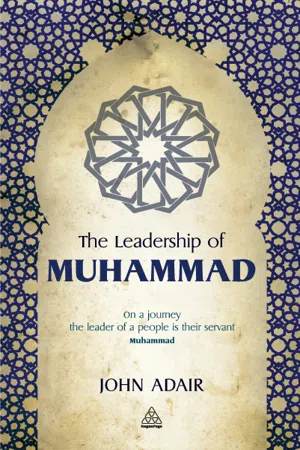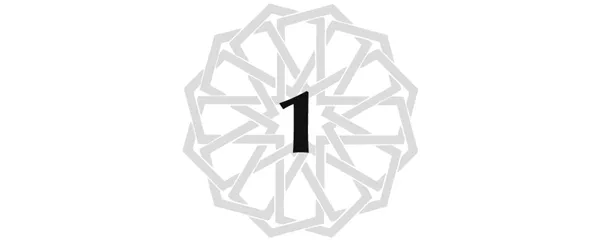![]()
In the Black Tents of
BANI SA’D
Truly, I am the most perfect Arab among you. My descent is from the Quraysh, and my tongue of the Bani Sa’d.
MUHAMMAD
Early one morning in 570 CE a Bedouin man and his wife left the town of Mecca heading north-east to their camping grounds in the Najd, a great desert area in central Arabia to the north of the Nefud and the Rub’al Khali regions that forms a plateau of about 1,500 metres (5,000 feet) high. Al-Harith ibn Abd al-Uzza of the Bani Sa’d, a section of the much larger Bani Hawazin tribe, rode on his camel, and his wife Halima bint Abdallah followed on a donkey carrying her baby son Abdallah and an eight-day-old baby of the Quraysh tribe from Mecca that she was bringing home to suckle – Muhammad.
After a journey of nine days they reached the black tents of the Bani Sa’d in a wadi, a dry river valley dotted with solitary acacia trees and some sparse pasture for the flocks of sheep and goats. Once they were near the tent Halima’s young daughters Unaysa and Judama (or Shayna, as she is called in other sources) – ‘the girl with the beauty spot’ – rushed out with cries of excitement to greet the return of their parents and brother and to make the acquaintance of their new baby foster-brother. Judama, the older of the two, would later remember helping her mother in the days that followed by carrying the baby Muhammad around on her hip.
The long and low desert nomads’ tent that was to be Muhammad’s home was made from strips of coarse cloth woven by the women from goats’ hair, which gave it the distinctive black or dark-brown hue familiar to travellers down the ages. Called in Arabic a beit ash-sha’ar, ‘house of hair’, it was divided into two by a low curtain separating the sleeping quarters – also the domain of the women and children – from the master’s quarters (Arabic: manzil), where the master of the tent entertained other men – his relatives or guests – or if alone shared meals with his wife and children. This half of the tent would be furnished with camel-saddles, camel saddle-bags and cushions around the central hearth where the blackened cooking vessels and gleaming brass coffee pots stood ready for service.
Muhammad’s earliest memories as a child included playing with the lambs that chased each other about or lay inert in the shade under the eaves of the tent. These lambs were too young to follow their mothers in the main flock. Led by the shepherds, the flock wandered for hours in the heat of the day over several miles, nibbling the odd blades of grass or vegetation. Muhammad had a particular fondness for the more agile goats, as well as for the half-wild cats that chased the desert scorpions and other unwelcome visitors around the tent’s guy ropes. In later life Muhammad, according to legend, once cut a square out of his cloak to avoid disturbing a sleeping cat, such was his affection for them.
Muhammad appears to have stayed with Halima’s family until he was 5 or 6 years old, although sometimes foster-children remained with their Bedouin foster-parents until they were 9 or 10 years. The chief reason given for this old custom among Meccans of farming out their baby sons to Bedouin foster-mothers was health: children brought up in the open-sided black tents were generally hardy and robust, whereas those reared in the crowded and unsanitary houses were exposed to lethal fevers and pestilence. The dry, clean air of the desert on the Najd plateau, the constant fresh wind and the healing sun kept the tents of the desert nomads such as the Bani Hawazin relatively free of disease. Both Muhammad’s natural father and his natural mother would die young of fever in Mecca, leaving him an orphan before he was 7 or 8. No wonder that his Bedouin mother Halima meant so much to him.
But below the surface there is a deeper motive why the Quraysh noble families sent their babies to be fostered in Bedouin tents. All Arabs know that by origin they are desert nomads, tent-dwellers and herders of camels, sheep and goats, migrants in the vast land of Arabia. Their values, culture and language are all the products – as it were – from that aboriginal life of freedom in the black and brown goatskin tents of their forebears. Those who would be leaders of the Arabs, tradition suggested, should have Bedouin milk in them as well as the Bedouin blood in their veins that they shared with all Arabs.
The Bedouin – still the vast majority of Arabs in Muhammad’s day – were also regarded, at least by themselves, as the purest and noblest of the Arab people. When a Meccan town-dweller made a slighting remark about the desert nomad tribes to a visiting Bedouin chief, the chief dismissed the remark with dignified contempt, for the Bedouin of the great ancient tribes knew themselves to be second to none on earth, equal if not superior to those tribes like the Quraysh who had left the desert for the mud-brick or stone-built houses of the few small towns and oases.
Both Abu Bakr and Umar, the first and second caliphs, as the successors of Muhammad were known, had the same experience of being reared by Bedouin foster-parents in their desert tents. Once, for example, when Umar rode through a wadi called Dajnan in the desert east of Mecca, its familiar landscape stirred in him a memory of those distant days of a childhood among the Bedouin.
‘There was a time,’ he recalled to his companions, ‘when I roamed the desert as a camel-herd, dressed in a fleece jacket, and whenever I sat down tired my father would beat me. Now I live in a time when I need reckon none my superior except God!’
The example of Muhammad – the perfect Arab in the eyes of Muslims – helped to perpetuate the tradition of noble families giving their male babies into the care of Bedouin foster-parents. In the 19th century, for example, the practice was still common among the Sharifs (Arabic: honoured, high-born), those families in Mecca who claimed to be in the line of direct descent from Muhammad, such as the Hashemites. Other prominent Arabic ruling families also followed the custom. The present Emir of Qatar, for example, like the Prophet had a Bedouin foster-mother. What the future amir (Arabic: commander, leader) absorbed with his Bedouin mother’s milk was a knowledge of the ways and manners of the Bedouin – the people the ruling families would govern in peace and command in battle. In Arabic these manners – the customary, well-trodden path of tradition, or normative rule – are called sunna.
After his return to Mecca and the death within two or three years of his natural mother Amina, Muhammad was brought up first in the house of his grandfather Abd al-Muttalib. When this man, whom Muhammad admired and revered, died he was passed on to another guardian, an uncle called Abu Talib.
Occasionally, the tradition tells us, Muhammad’s Bedouin foster-mother Halima when visiting Mecca would call to see him. When Muhammad saw her coming towards their house, he would run out to meet her and welcome her warmly with ‘Mother! Mother!’ Leading her by hand into the house he would spread out his abaya – a wide, sleeveless cloak – on the floor and beckon her to sit on it with him, a Bedouin gesture of special reverence or respect reserved for an honoured guest. On one occasion later in life, during a drought year, Muhammad even persuaded his wealthy wife to give Halima a gift from them – a camel and 40 sheep.
One day – over 50 years later – Muhammad’s second family among the Bani Sa’d were able to profit again from their claim on Muhammad’s affections, for milk-brotherhood among the Bedouin is held to be as strong as blood-ties, the sacred bond of the tribe.
It came about like this. In February 630, more than 50 years after Muhammad’s childhood doings in their tents, about 4,000 tribesmen from the Bani Hawazin ambushed a Muslim army almost three times their number. The Muslims had invited trouble by incautiously advancing along the narrow bottom of Wadi Hunayn without having sent out scouts. It was a natural place for an ambush. Suddenly, pouring down the hillsides from both sides, came down upon them the Hawazin warriors shouting their war cries. The charge of the Bedouin on camel and horseback, waving their lances and swords, caused panic in the Muslim ranks: the advance guard broke ranks and fled down the valley, straight into the main body, throwing them into confusion. The worst thing that infantry can do is to present their backs to the lances of the enemy horsemen as the Muslims were now doing. In a verse referring to this battle of Hunayn the Qur’an says: ‘Then the very earth, in spite of its extent, seemed too small to provide a refuge for you when you turned your backs in flight’ (Q9:25).
Muhammad, aged 60, was present in the valley and witnessed that panic moment ‘when you turned your backs in flight’. Wearing his chain-mail coat and sitting astride a white mule, the Prophet stood his ground with his dedicated bodyguard surrounding him. ‘Where are you going, men? I am the Messenger of God. I am the son of Abd al-Muttalib’, he shouted above the noise.
Eventually a number of Muslim soldiers were persuaded by their leaders to turn and engage the Bani Hawazin in fierce hand-to-hand fighting. ‘Now the oven is getting hot!’ cried the Prophet. He was seen to lean forward eagerly to watch as the tide of the fighting ebbed and flowed. If a Bedouin tribe’s fighting force did not break their enemy with that first wild charge they seldom lingered long, for they were usually after booty or honour, not death. In a short time the Hawazin broke away and ran for their lives.
Among the captives seized in the tents of the Bani Hawazin that had been pitched near to the battlefield was an old Bedouin woman of the Bani Sa’d who loudly claimed that she was the Prophet’s sister. At first the Muslim soldiers merely laughed at her, but her persistence eventually won the day and two of them escorted her to Muhammad’s distinctive tent, which was made of strips of leather dyed red. He came out to greet them. The old woman stepped forward.
‘O Muhammad, I am your sister’, she said simply. Notice that she used his first name. She exhibits here what you will find is one of the coloured threads woven into the carpet of this book, namely that peculiar mixture of affectionate respect and simple familiarity that is the charm of nomadic society.
‘Have you any proof of that?’ Muhammad asked her, for he did not recognize her by her face.
She replied by pulling up the sleeve of her dress to reveal the w...




